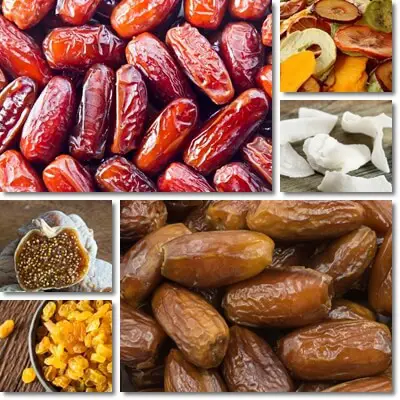There’s a longstanding belief that fruit are a healthy snack, whatever the form they may come in, and you can eat them in unlimited amounts – the more, the better. Some will even go as far as saying that it’s better to have fruit in a pie or some other sweet dessert than not have it at all in your diet. But that isn’t true at all. In fact, the only real healthy form of fruit is fresh fruit eaten whole – in moderation, of course. Fruit juices are technically healthy too, but they also raise blood sugar levels and risk damaging teeth if consumed regularly, even in small amounts. As for dried fruit, they are packed with calories and some have sugar and fat added to them to improve their taste which means they can raise blood sugar, cause weight gain, so they’re basically only healthy when eaten in limited amounts.
So how do you turn dried fruit into a healthy snack you can enjoy without having to worry about side effects? Can all kinds of dried fruit make a healthy snack or just some? And what makes a type of dried fruit healthy and better than others? By just considering the following aspects of nutrition, you too can enjoy your favorite dried fruit options and the benefits they have to offer for your health, without any of the side effects.

Portion control
Excesses are never good for you. While overall healthy, dried fruit are not a good food to eat in large amounts, or too often for that matter. Yes, they’re healthy, packed with essential nutrients, vitamins and minerals, as well as fiber and antioxidants. But they’re also packed with sugar, natural and sometimes also added sugars (example: dried kiwifruit, sour cherries) and even fat (example: in addition to having added sugars, banana chips are sometimes fried, while dried cranberries often have added vegetable oil). Whatever your choice of dried fruit, remember to have small amounts at once. How much is a typical serving? About one ounce, or one oz, or the equivalent of 28.35 grams. Usually one serving a day is enough, preferably not every single day.
But if dried fruit are your favorite, you can probably work out a way to eat them every day, or almost every day. For example, you can have a serving of dried fruit instead of a processed dessert, or instead of a serving of fresh fruit or nuts. But not all of them at once and definitely not all of them every single day. The important thing is to consider the nutritional input of the dried fruit of your choosing, preferably per serving, so you can determine how much of it you can eat a day, how often you can eat it and what impact it will have on your health long-term. Consider aspects of nutrition such as energetic value or calories, fat content, carbohydrates, sugars, fiber or essential micro-nutrients, or, better yet, all of these nutritional facts together.
Healthy vs less healthy
While dried fruit are generally a healthy food option when compared to processed desserts, not all types of dried fruit are equally healthy, which is why you need to learn to choose the best kinds of dried fruit. The healthiest would have to be the traditional dried fruit options such as prunes (or dried plums), pears, apples, apricots, peaches, dried persimmon or kaki, figs and dates as well as dried goji. These can be sun or shade dried, oven-dried, dehydrated in special machines etc. They don’t need or usually have added sugars or fat, but may contain additives to prevent oxidation and browning and increase shelf life (usually sulfites such as sulfur dioxide). Look for options with no added sugar or additives.

Less healthy options include sour fruits which are typically sweetened with sugar such as sour cherries, kiwifruit, red cranberries, and even banana chips and blueberries. Other types of less healthy options include dried fruit that have added fats such as dried cranberries which are known to contain vegetable oils to better help the added sugar take to the skin of the fruit. If you do eat dried fruits frequently, these aspects of nutrition may help you choose healthier options, reconsider intakes/serving size or simply consider their nutritional impact more carefully.
Additives and allergies and sensitivities
Whenever we consider introducing a food into our diet, it’s always good to think about how it affects us personally. Food sensitivities, instances of intolerance and especially food allergies can occur in response to many kinds of foods, including dried fruits. Some people are allergic to bananas, some to cherries or sour cherries etc. Others are sensitive, intolerant and even allergic to additives such as sulfur dioxide or other sulfites which can be present in all kinds of dried fruits. These compounds are used to prevent oxidation, rotting, increase shelf life and enhance color for a greater appeal.
For example, raisins, prunes and dried apricots and peaches are the most commonly eaten types of dry fruits and all have sulfur dioxide or other sulfites. As a result, they can and will trigger symptoms of intolerance or food allergies in people predisposed to them. Those sensitive or intolerant to additives in a dry fruit can look for options without additives. Those allergic to a fruit or the additives used in its dry variant should absolutely avoid it the fruit or additive in all forms and preparations.
Read the label
Even if it’s common knowledge that dried figs, dates or prunes require no additives for color enhancement or a longer shelf life, they may still contain sulfur dioxide. Even if you choose the less appealing reddish-brown dried peach halves or the brown raisins instead of the more appealing golden ones, thinking they have no sulfur dioxide to give them that bright golden glow, that’s not a guarantee they are sulfur dioxide-free. Even if you choose the bitter dried goji or the sour dried cranberries thinking they are healthier than other options, they may still have added sugars, sulfites or other additives.
Even your favorite brand of dried fruit can one day change its manufacturing process or policies – a tiny line of text on the back of a colorful package that you can easily miss. So whether you like to eat prunes or apple chips, raisins or coconut flakes, dried cranberries or goji, have a look at the label, at least from time to time. This is just as important as remembering to eat your dried fruits in reasonable amounts, one small serving a day, preferably not every single day. And always considering any dietary restrictions you may have, such as the need to control carbohydrate intake and manage blood sugar in type 2 diabetes. That is, if you want to make eating dried fruit a healthy diet habit.
